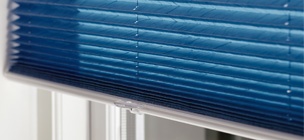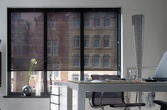
Child Safety
Child safety is serious business, and making window treatments safe for homes with infants, young children and pets has always been a top priority at Hunter Douglas.
The European Committee has recently revised the child safety standard for internal blinds, EN13120. EN13120 is accompanied by two new standards: EN 16433 which deals with the test methods associated to protection from strangulation for complete products and EN 16434 which covers specific requirements related to safety devices integrated in internal blinds.
We aim to help create awareness regarding child safety matters among everyone involved in internal window blinds (design, manufacture, supply and installation), so you can plan to ensure compliance with the new standards. For a more comprehensive overview of the new regulations please download our brochure here.
About EN13120

Introduction to EN13120
The standard applies to all internal blinds, such as (but not restricted to):
- Venetian Blinds: free hanging, guided, non-retractable;
- Roller Blinds: free hanging, side guided, with tensioned fabric;
- Vertical Blinds: free hanging, with top and bottom track, sloping headrail;
- Pleated and Honeycomb Blinds: free hanging, guided, laterally moving, tensioned;
- Roman Shades;
- Austrian / Festoon Blinds;
- Panel Blinds;
- Roll-up Blinds.
The standard does not apply to draperies, curtains and insect screens, nor to blinds in sealed glazed units with the exception of requirements related to protection from strangulation. The standard is not applicable to internal blinds manufactured before the date of publication of this standard. The standard is not applicable for blinds which are intended to be installed in premises where children are unlikely to have access. However, the standard does apply to blinds where the use and/or destination of the blind is unknown. From: EN 13120
Operating Length
When only a loop tensioner (see Child Safety Components) is used,
the table and notes show how this can be communicated in the
technical dealer info.

Technical Dealer Info
- This table only applies to orders where installation height has not been specified.
- If installation height is specified, maximum operation length is installation height minus 150 cm, rounded down to first chain loop length from standard table to the left.
- A chain tensioner will be attached to each chain, to mount the chain to the wall in a safe manner.
- The table only specifies operation length per product height, and does not indicate maximum possible product height for this product.
Child Safety Components
Highlighting some of the most important requirements and solutions. For more detailed information please consult our brochure.

Chain Tensioners
- 6 kg must be pulled sideways on the chain, the tensioner must not break or stop functioning.
- The tensioner must also function if it’s mounted 10 mm higher than the intended position.
- Maximum distance between the two strands is 50 mm.
Our Solution
- Simple versions, usually plastic, to be screwed on the wall, window frame or windowsill.

Breakaway Chain Connector
- The component must be tested on mechanical properties, and UV and temperature resistance.
- With 6 kg pulling downward on the chain, the chain must break. The component itself therefore must release at 3 kg.
Our Solution
- Two part system. Breaking force is not dependent on the ball size. Will become available this summer.

Cord Cleats
- Product has to be mounted in such a way that cleat is at minimum 150 cm above the floor.
- If you pull on the cleat or on the cord with 6 kg, no more than 10 cm of cord is allowed to come loose.
Our Solutions
- Cord cleats, usually plastic. Must be attached to the wall and may not rotate afterwards.
- Two buttons, available in two sizes, to be screwed to the wall or window sill, in different positions. Will become available this summer.

Breakaway Cord Connectors
- The component must be tested on mechanical properties, and UV and temperature resistance.
- To fit up to four cords.
- To release the cord when a force of max 6 kg is exerted on the loop.
Our Solution
- There are a lot of different solutions available on the market.

Child Safety Click Ring
- The component must be tested on mechanical properties, and UV and temperature resistance.
- Use when the space between two connections to the fabric is more than 20 cm (often the segment height).
- Must open/ break when a force of max 6 kg is exerted on the loop.
Our Solution
- The click ring depicted here only works in combination with the Hunter Douglas ring, article code 28.1940.7178.
Operating Systems

Cord Operated Blinds
Pull Cords
- The operation length must be limited. A cleat must always be included, and the cord must be pre-wound on the cleat when packaging the blind.
- Specific mounting instructions must be provided.
- If there are two cords coming out of a headrail, they must not tangle. If there are up to four cords coming out of the headrail, the cords must be connected with a breakaway cord connector.
- If there are more than four cords coming out of the headrail, it is allowed not to use a breakaway cord connector. These cords must be connected to a single cord, within 5 cm of the headrail with a breakaway device.
Single Retractable Cords
- Also called ‘Hunter Douglas SmartCord®’. The operation length must be limited. Cleat is not necessary.
Operating Cords
- Each cord must be limited. No cleat necessary.
- These cords must not tangle.
Single Pull Cords
- To eliminate any risk of strangulation, the length of the cord must not be longer than 20 cm.

Crank Operation
This operating system is child safe as there is no risk of strangulation
Cordless Blinds
Also called 'LiteRise®’. The blind is pulled up and down directly touching the bottom rail without any operating cords or chains. As there is no risk of strangulation with this operating system, this operating system is child safe.
Electric/ Motorised Blinds
This operating system is child safe as there is no risk of strangulation.
Solutions per Product
In this section only the most important features which may make the product not to comply with the child safety requirements of EN13120 are highlighted. Always limit the operation length of the blind as described in Chapter 2 of our Brochure.

Roller Blinds
- On chain operated Roller Blinds, add a tensioner or a breakaway chain connector.
- Manually operated, crank operated or motorised roller blinds are safe.
- If applicable, limit the length of the pull cord that hangs from the middle of the bottom rail.

Roman Shades
- Be aware of the loops that can form at the backside of the Roman Shade between the lift cords and the fabric.
- Add a cleat to all cord operated shades. When four cords or less come out of the headrail: use a breakaway cord connector. When more than four cords come out of the headrail, at least tie the cords together within 5 cm from the headrail when the blind is in lowered position.
- Add a tensioner or a breakaway chain connector to chain operated Roman Shades.

Venetian Blinds
- Add a cleat to cord operated blinds. When four cords or less come out of the headrail: use a breakaway cord connector. When more than four cords come out of the headrail, tie the cords together within 5 cm from the headrail when the blind is in lowered position. It should not be possible to pull the cord back through the headrail, which could create a dangerous loop.
- On chain operated venetian blinds, add a tensioner or a breakaway chain connector.
- Tensioned models are safe as long as there are no cords or chains that can form a dangerous loop.

Vertical Blinds
- On cord operated Vertical Blinds, add a cleat.
- On chain operated Vertical Blinds, add a tensioner or a breakaway chain connector.
- On Vertical Blinds that have both a cord loop and a chain loop, there are several options: (1) Use two tensioners – guide both loops through a single tensioner. (2) Use a breakaway chain connector on the chain and a chain tensioner for the cord loop.
- Tensioned models are safe as long as there are no cords or chains that can form a dangerous loop.

Paneltrack Blinds
- On cord operated Paneltrack Blinds, add a cleat.
- On chain operated Paneltrack Blinds, add a tensioner or a breakaway chain connector.
- Wand operated or motorised Paneltrack Blinds are safe.

Plissé & Duette® Shades
- On cord operated shades, add a cleat. When four cords or less come out of the headrail: use a breakaway cord connector. When more than four cords come out of the headrail, at least tie the cords together within 5 cm from the headrail when the blind is in lowered position. Be aware that it should not be possible to pull the operating cord back through the headrail, which could create a dangerous loop.
- On chain operated pleated blinds, add a tensioner or a breakaway chain connector.
- Tensioned models are safe as long as there are no cords or chains that can form a dangerous loop.
- LiteRise®, a patented and child friendly, cordless system.
- SmartCord®, a revolutionary, patented cord lifting system featuring a retractable pull cord that maintains a constant length (no more dangling cords).



